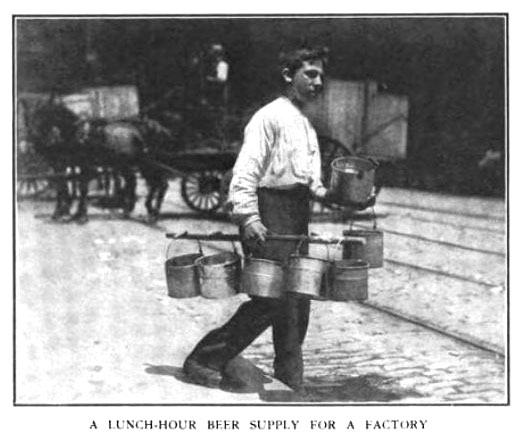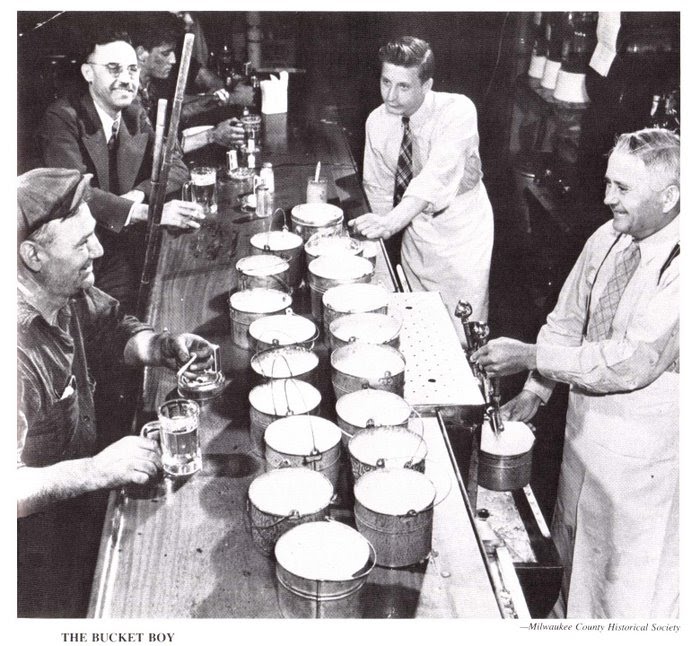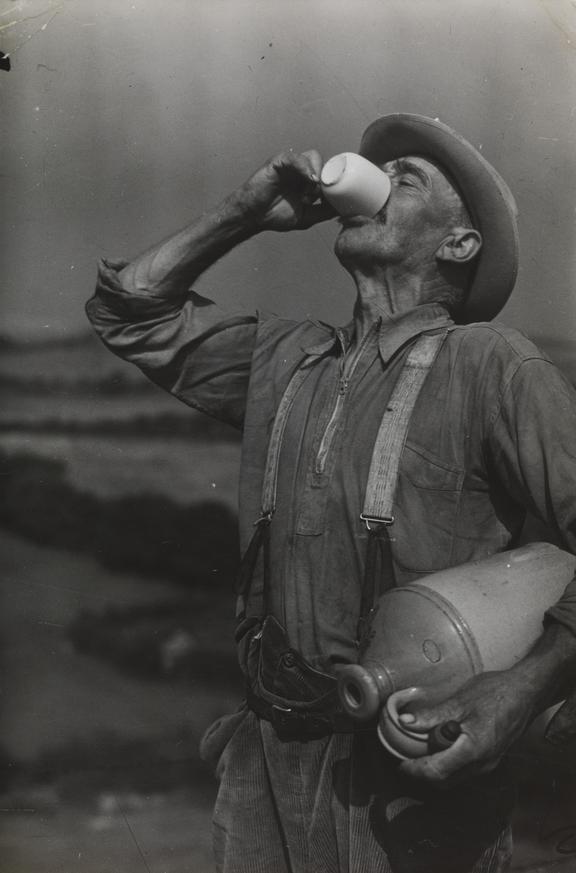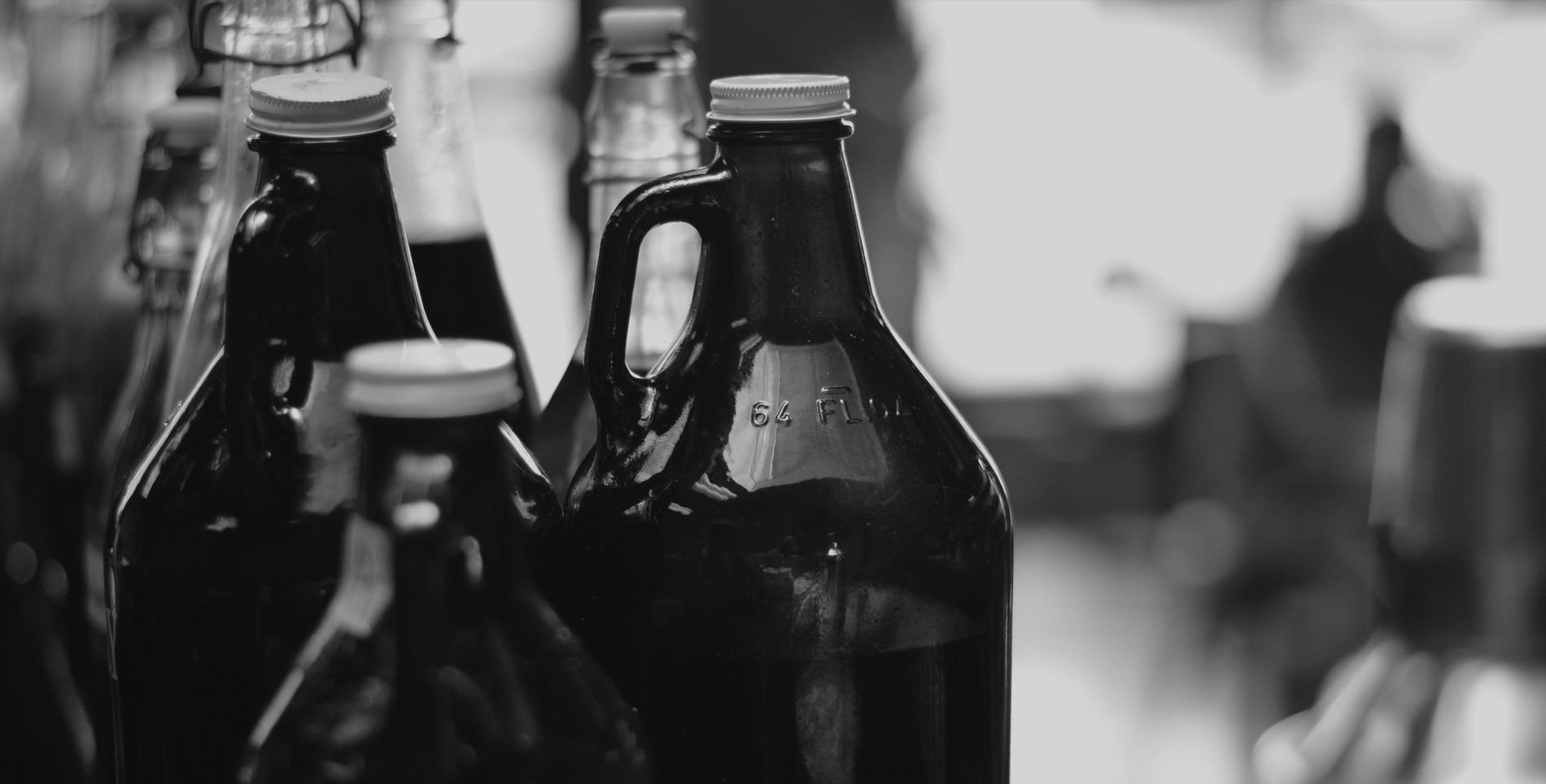Growlers have been making drinking at home ergonomically and economically possible since the early 1880s. While today we spot them as large glass jugs with a loop near the lid, they humbly began as galvanized pails used as coolers to carry fresh beer home from the local brewery or pub. And as carbonation escaped from the lid, the growling sound eventually coined these pails as growlers.
Or so one theory goes. Another suggests the name comes from the “growling” that would often erupt between bartender and customer on how much beer pails should be filled (foam space can be subjective). Another is that “growler” referred to the sound of a filled pail sliding across a bar.
There’s even one more theorized origin story—a growler is in reference to the stomachs of hungry laborers growling for their lunch pails of beer. In the time before Prohibition, liquid lunches were often delivered in bulk by entrepreneurially-minded children who would earn money filling and delivering beer pails. Such deliveries were known as “rushing the growler.”
Regardless of where the term comes from, the growler remains an uncontested essential for both beer drinker and producer alike. It’s a handy vessel, the presence of which has threaded history with a common truth, one made even more relevant in light of Covid-19: we share what we like to drink, and we’ll do it even when things are tough.


A History Reinvented
After Prohibition, galvanized pails were replaced with more sanitary refillable jars (some in half-gallon form were known as “picnic bottles”), waxed cardboard containers, and eventually plastic. It wasn’t until the late 1980s—almost a century after the first patent for a growler, then termed “beer cooler,” was registered in the U.S. in 1901—that the looped glass jug we know today as a growler was born. This resurgence is credited to Charlie and Ernie Otto of Grand Teton Brewing.
Known at its founding as Otto Brothers’ Brewing Company, Wyoming’s first microbrewery was draft only. When Charlie came across an old tin beer pail of his father’s in the attic, a lightbulb went off—here was a way for customers to enjoy Otto Brothers’ drafts at home. He silk-screened his logo on the side of a half-gallon cider jug, and the modern-day growler roared to life.
The practical nature of growlers has contributed to their longevity. Growlers enable breweries to sell a greater volume of product than what customers could solely consume at the bar. It’s a beneficial way for small craft breweries to grow with limited marketing dollars, and drinkers are happy too. Beer aficionados are known to carry empty growlers in their car, frequently filling and refilling them at their favorite brewery.

Although the classic, sixty-four-ounce amber jug is still the most widely recognizable form, a desire to keep beer fresh, air-tight, and temperature-controlled has evolved the growler from a screw-cap glass jug to include swing-tops and pressurized caps, with bodies made of stainless steel, ceramic or even copper. Brands like MiiR take a modern, minimalist approach to their insulated, leak-proof steel growlers, while others, like Takeya, offer growlers in the shape of a water bottle with an insulated spout, drinkable straight from the lid.
If it was properly filled and sealed with CO2, an unopened, chilled growler can keep a beer fresh for two to five weeks. Once oxygen is introduced, however, a beer will start to go flat, so it’s advised to best enjoy a growler within twenty-four to forty-eight hours after opening.
And Reinvented Again
As Covid-19 shuttered bars and restaurants across the globe, growlers have emerged not just as a way to keep beer from going to waste, but to keep establishments in business. In Los Angeles, where growler sales were previously restricted to establishments with specific off-premise licenses, Safer at Home measures have temporarily expanded those restrictions to allow any establishment to sell beer for takeaway. For this, growlers are an obvious choice.
“Ever since we got closed down, the only way we could keep distributing our tap beers has been through growlers,” says Peggy Simonian, owner and operator of Lucky Baldwin’s Pub, which has three locations in Old Town Pasadena, East Pasadena, and Sierra Madre. Of the sixty-five taps she has at the East Pasadena location, Simonian has been able to sell her American craft beers to-go in growlers.
“It’s giving people the feeling of ‘something better than nothing,’” she explains. “They’re not able to get the true experience of being in a pub or a bar, but at least they can bring a bit of it back home.”
Whether Simonian and others licensed only for on-premise alcohol consumption will be able to continue selling growlers now that the Safer at Home restrictions have been lifted—a decision dictated by California’s Department of Alcoholic Beverage Control—remains unknown.
Similarly, Gail Casburn, owner of the Altadena Ale House, also credits the power of the growler for keeping her business afloat. She’s been working on her own, ten to twelve hours a day, seven days a week since the shutdown.
“If I can make one buck instead of zero bucks, I’m winning,” she says, explaining while she has had the license to sell growlers, she’s never sold them before now. “[Growlers are] helping to get people in the door and give me exposure in the neighborhood, because I’m the only one open for draft beer to go.”
At the beginning of the shutdown in March, Casburn was also selling hard-to-find items like toilet paper, butter and milk. Although the demand for pantry staples has since waned, growler consumption has remained steady.
“I get anywhere from two to ten orders a day, which helps pay the bills,” she continues, referring to the bar she’s owned for ten years. “They’ll also get a pizza to go or buy other things, but some people just come in to get growlers filled.”
And it’s not only beer that has benefitted from the growler. In its simplest form, the jug also makes batch purchases of soap, shampoo and cleaning products possible. Whether stocking up on basics or trying to avoid single-use plastics, growlers have proven to be a bulk goods essential.
“Right before Safer at Home went into effect, people were stocking up and we were flying through growlers,” explains Leslie Campbell, founder and CEO of Sustain LA, a retail store and events company that promotes zero waste living. Sustain’s products include dish liquid, laundry liquid, shampoo, conditioner and hand soap that, previously, customers could either load into their own containers, or gallon or half-gallon growlers they purchased in-store.
“Since then, we’ve moved to a pick-up and delivery model exclusively,” Campbell continues. “We use growlers in the same way, to prep and fill orders for customers; they are then returned for a deposit if the customer doesn’t want to keep them.”
With such a demand for growlers, both new and renewed, manufacturing pipelines have correspondingly been stressed. A representative from ARTon Products, a Virginia-based glassware supplier that procures U.S.-made growlers, confirms a domestic shortage as well. They had initially purchased growlers “by the truckload” to meet the increased demand from bars, restaurants and wineries with closed tasting rooms. Now, all growlers are on backorder, as suppliers like ARTon and others wait for manufacturers to begin new rounds of production. Dates of availability vary from as early as mid-June to as late as July.
“We currently offer both crowlers [the can version of a growler] and growlers, however, we are moving primarily crowlers right now,” says Daniel Munoz, head of marketing for The Bruery based in Placentia, California. “That is because we do not currently offer refills on growlers.”
Citing safety and the many contact points it takes to refill a growler, Munoz explains they’re currently only selling new growlers, which deters many because it’s an additional fee to purchase the growler, plus the fill. “Once things are back to normal,” he says, “we’ll offer refills on growlers again and we’ll likely see that volume pick back up.”
As that elusive normal haunts us all, may we look to the unlikely players propping us up and helping us get there, one swig at a time.



Our comments section is for members only.
Join today to gain exclusive access.